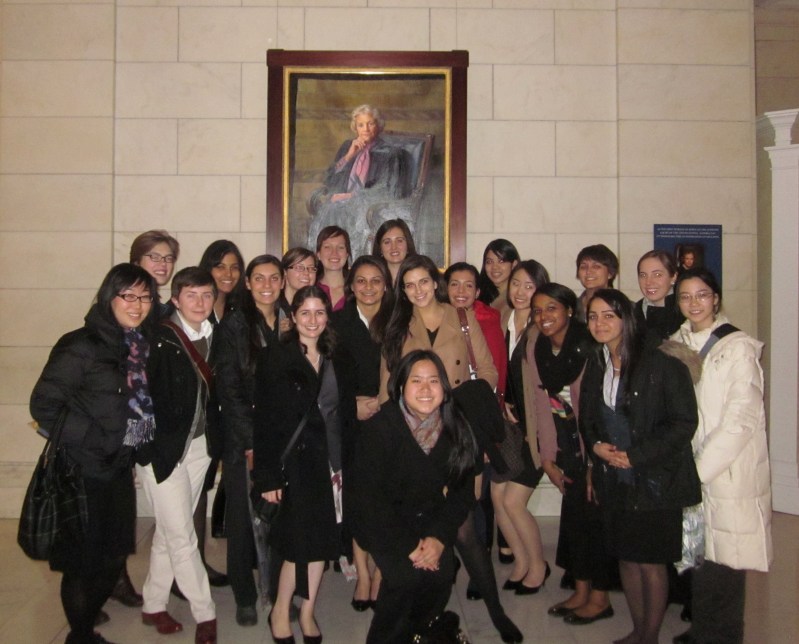Hello All –
Nikki here. Allow me to introduce myself. I’m a senior at Wellesley, majoring in Neuroscience and minoring in Education Studies. After graduation this spring (eek!), I’m hoping to do research for a couple of years before going back to school to get an M.D./Ph.D. Although I don’t see myself working directly in politics, I see that science and healthcare operate on policies set in Washington. I think it’s important for scientists and healthcare providers to be informed about policy to be effective advocates for their fields. As such, I decided to do the Wellesley Wintersession program in Washington to learn more about how politics actually work in Washington – something about which I am embarrassed to admit I know very little. Throughout our program I’ll be updating with my impressions from our meetings and fun-facts I’ve learned.
Day 1 was so so great. We walked from our hotel near the Capitol to the Supreme Court. There was already a long line of people waiting to get in for the morning arguments. Thanks to our amazing site coordinator, Aprill Springfield, we had reserved seats on the court floor so we were ushered in a side door. After we went through the security check (metal detector and bag check like at the airport) we proceeded on to the main foyer where there were display cases highlighting interesting facts about the building. Check out the Supreme Court website for more info. When we got upstairs to the level of the court, we had to check all of our belongings in lockers and then go through another security checkpoint. The courtroom was beautiful and very regal with fancy foreign marble floor and pillars, red and gold velvet drapery, bronze doors surrounding the space, and impressive marble friezes at the top of the wall by the ceiling. The justices were seated by seniority, with Chief Justice Roberts in the middle and the other justices alternating outward on either side by seniority.
The justices came in promptly at 10:00am and the arguments began after some new members of the supreme court bar were sworn in. We heard two arguments: 1) Sackett v. Environmental Protection Agency (EPA) and 2) Kappos v. Hyatt. I had done a little research on the cases beforehand(check out http://www.scotusblog.com/case-files/cases/sackett-et-vir-v-environmental-protection-agency-et-al/ and http://www.scotusblog.com/case-files/cases/kappos-v-hyatt/ for more info), which was a big help in understanding the fast-paced dialog between the justices and the attorneys. I noticed differences in style between the justices approach to questioning. Some were more outspoken (e.g. Antonin Scalia and Elena Kagan) than others (e.g. Clarence Thomas, who didn’t ask a single question in either case). They asked different types of questions too. Veronica noted that Sonia Sotomayor asked very fact-based questions, whereas John Roberts asked philosophical questions. I thought maybe this reflected different levels of interest in the cases.
After lunch we had a formal tour of the supreme court and then the INCREDIBLE opportunity to meet with Sonia Sotomayor. After a brief introductory statement, she opened the meeting up to questions from her. I asked her about the justices’ differences in style, to which she offered an interesting explanation. She said that Justice Thomas never asks a question in court, as he’s interested primarily in what the attorneys feel is important to discuss. He knows the law as it’s written, and wants to know how the attorneys challenge or defend that based on their own interpretation. Justice Sotomayor said her fact-based, analytic approach is largely due to her experience in district courts. In contrast, many of the other justices served in circuit courts, which impress a more philosophical approach. She also had some great comments on the challenges to women breaking the glass ceiling. I was so impressed by her honesty and warmth and thoughtfulness. She seemed genuinely interested in answering our questions and making a meaningful connection with us. She discussed her hope for future generations making meaningful contributions to society through commitment to public service.
In the evening we had a panel with five Wellesley alums working in non-profit public service. Ada Meloy (’71), Alex Guild (’03), Lori Wallach (’86), Shannon Garving (’96), and Margot Conrad (’03) gave us some great advice on following our passions and using the Wellesley network to advance our careers. They all emphasized that passion for the cause is a common thread in the non-profit sector.
It was a long, but rewarding Day 1. I’m looking forward to the rest of the trip!!
-Nikki

